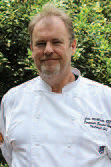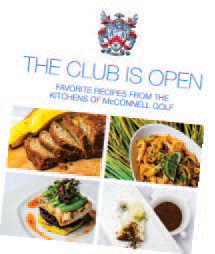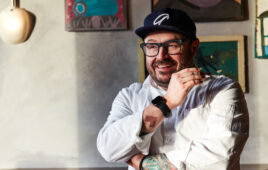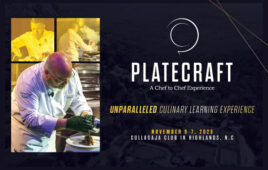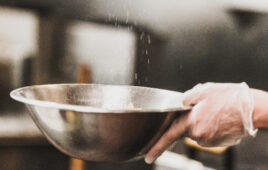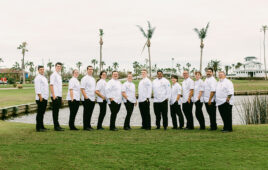By Jerry Schreck, Executive Chef, Merion Golf Club, Ardmore, Pa.
McConnell Golf, based in Raleigh, N.C., was founded by John Mc- Connell in 2003. McConnell now owns and manages eight clubs in North and South Carolina. As the company grew, the need for a Corporate Executive Chef became apparent. The likely candidate for the job, John McAllister, was already on staff at the Old North State Club in New London, N.C.
CHEF PROFILE
Current Position:
- Corporate Executive Chef, McConnell Golf LLC.
- Executive Chef/Food & Beverage Director, Old North State Club, New London, N.C. (2004-Present).
- Executive Chef, Roanoke Country Club, Roanoke, Va. (2001-2004).
- Executive Chef, Rock Hill Country Club, Rock Hill, S.C. (1998-2001).
- Executive Chef, Cabarrus Country Club, Concord, N.C. (1991-1998).
Awards/Accomplishments:
- Awarded title of Chevalier by the Les Amis du Vin International Wine Society.
- Won International Helix Escargot Contest, 1982.
Professional Affiliations:
- Held position of Vice President and Apprenticeship Director, Charlotte Chapter, American Culinary Federation.
- Member Chaine des Rotisseurs.
Chef McAllister, CEC, started his career in Cleveland, Ohio, where he owned two restaurants that gained critical praise and acclaim. He migrated south and switched gears to enter the club industry, where he developed Southern-style culinary techniques that only enhance his classic French background.
John was good enough to take time to tell us what it’s like to oversee Old North’s kitchen, which houses McConnell’s culinary apprenticeship program, as well as have corporate oversight of seven other very busy F&B operations.
Q. John, what are the advantages for a chef as a member of a corporate management team with eight golf properties that all have extensive F&B programs?
A. First and foremost, a significant advantage is that I interact with a highly skilled and directed group of people that makes up the McConnell corporate team. The opportunity to learn and grow as a professional is a constant, and what I bring to the table in terms of food-and-beverage knowledge is more than matched in areas such as finance, golf operations and membership services.
The eight McConnell Golf properties, and their Executive Chefs, include:
- Cardinal Golf & Country Club, Greensboro, N.C. (Michael Coleman Monahan)
- Musgrove Mill Golf Club, Clinton, S.C. (James Patterson)
- Old North State Club, New London, N.C. (John McAllister)
- Raleigh Country Club, Raleigh, N.C. (Dennis Freeland)
- The Reserve Golf Club, Pawleys Island, S.C. (Grayson Glascock)
- Sedgefield Country Club, Greensboro, N.C. (Ben Hollinger)
- TPC at Wakefield Plantation, Raleigh, N.C. (Todd Jackson)
- Treyburn Country Club, Durham, N.C. (Pedro Villasana)
Just about every day, I gain insights into areas that are typically outside my daily sphere. I believe this makes me a more effective chef, as well as a better manager. I report directly to Christian Anastasiadis, Chief Operating Officer of McConnell Golf, and he provides challenging goals that require stepping out of the comfort zone to achieve.
Secondly, I have the great pleasure to visit all of the McConnell properties and spend time with our chefs way for many years does not mean it is the only way—and sometimes I see something one of our chefs is doing, smack myself on the head and think, “Why did I never think of that?
Another profound advantage is being able to help steer the direction of the company’s future culinary operations. It is very important to me to be a functional contributor to the team, and I bring the perspective of the chef position and how we can enhance the member experience.
Q. McConnell is now in its tenth year of owning and managing golf properties. What are some of the most important systems or programs that have been developed company-wide?
A All of our clubs have very distinct personalities, and as each one is acquired, it adds a new facet to the organization. In some cases we discover a better way of doing things that had not been evident, and we incorporate it system-wide. Other times, we see failed mechanics in the new property that confirm our current approaches. So our food-and-beverage departments are very much in continual development; we do not have cookie-cutter operations, and are always open to new directions.
We do, however, cross-market our clubs, because our members can avail themselves of services at all of our properties—which is a huge benefit. Take, for example, our ‘Chefs Unplugged’ series. We do about ten events a year that are hosted at our different properties and feature one or more of our chefs “visiting” another of our clubs and putting together an event. The themes can range from wine dinners to hors d’oeuvres parties with action stations manned by the visiting and host chefs. Todd Jackson, Executive Chef at Wakefield Plantation, even did an off-premise dinner modeled after a “pop-up” restaurant idea that was a big success.
In 2012, all of these events raised money for the Make- A-Wish Foundation, which John McConnell has matched. They will culminate on January 19th at Wakefield with a celebration gala that all of our chefs will participate in, preparing recipes from our McConnell cookbook, “The Club is Open” (see photo, above). These events weave a profound philosophical strand throughout our family of clubs, and very much support our culinary identities.
Quinoa and Grilled Venison Salad
Serves 4 to 6
| Amt | Ingredient |
| 1 cup | quinoa |
| 2 cups | water |
| 2 cloves | garlic, crushed |
| ½ cup | scallions, chopped |
| 1 cup | cherry tomatoes, split |
| 1 cup | cucumbers—peeled, seeded and chopped |
| ¼ cup | radish, sliced |
| 2 tbsp. | mint, chopped |
| 2 tbsp. | cilantro, chopped |
| ½ cup | parsley, chopped |
| ¼ cup | lemon juice, fresh |
| ¼ cup | extra-virgin olive oil |
| ½ cup | feta cheese, crumbled |
| ½ cup | kalamata olives |
| (to taste) | salt and pepper |
- Bring water and quinoa to a boil; let set for twenty minutes, or until liquid is absorbed.
- Combine remaining
ingredients and toss gently
with the quinoa.
For the Venison:
| Amt | Ingredient |
| 1 | venison rack, chine bone removed |
| (to rub) | olive oil |
| (to rub) | crushed juniper, black pepper and rosemary |
| (to taste) | salt |
Procedure:
- Cut rack into chops, one or two bones each, as needed.
- Rub chops with oil, seasoning and salt.
- Grill to medium rare, let rest, then slice.
- Arrange on plates with the quinoa.
Q. What can you share from your experience in putting the cookbook together to other club chefs who might be contemplating a similar project?
A. Well, to begin with, I can tell you that it is a lot harder than I ever imagined! I gathered in excess of 300 recipes from all of our chefs and began the process of culling down that number by trying to offer a balanced selection in terms of recipe types and degree of difficulty—I wanted to go from simple to complicated, both to showcase our skills and at the same time keep it accessible for various skill levels. Additionally, I checked every single recipe for amounts and techniques, to be sure they would work.
But as challenging as that was, the real heavy lifting began with the editing and organizational process, which was handled with incredible tenacity by Teresa Belote, General Manager of Cardinal Golf & Country Club, and Lauren Barry, Events and Marketing Director for McConnell Golf. The book would not have happened without their dedication and skill. For any chef considering going down this avenue, it is vital to work with individuals who can handle this part, because it is really what will determine the success or failure of the project.
Chefs tend to write recipes in our own shorthand, which always seems logical to us, but will usually mean nothing to an amateur cook. As carefully as I thought I was being in rewriting the recipes, Teresa and Lauren would bounce them back with questions about what an instruction meant, or to question a specific ingredient or measurement. This required me to review, rethink and correct—and then in some cases, do it all again. The result is a beautiful book that we are extremely proud of, and that has created a real buzz among our membership.
Q. Tell us about the brainstorming sessions held annually for the McConnell culinary teams.
A. There are many mini-meetings throughout the course of the year, but during the first quarter we gather all the chefs, food-and-beverage managers and event planners for a three-day meeting, which is typically held at the Old North State Club (we have a lodge on property).
Prior to this, we create an agenda and send it out to all attendees, with some “homework” projects to bring with them. The goal is to improve our operations through enhanced cost and quality controls, marketing opportunities and internal communications. In 2012, for example, some of the topics were social calendar standardization, base wine lists, inventory, and recipe-costing procedures. We also created a standard banquet menu, so we have consistency in pricing across the properties.
The chefs have a set of breakout meetings, during which we take a look at specific products, discuss procedures, and compare notes on techniques that we are using. We try to get as many ideas on the table as possible, and percolate them down to viable, workable actions. This year, for example, I want to get a discussion on sous vide going, to see if we can make an investment in the technology pay off. We will also focus on enlarging farm-to-table concepts system-wide this year, and continue discussion and implementation of sustainability in food and disposable wares.
 For an extended version of this
For an extended version of thisconversation with Chef John
McAllister, and a recipe for Crispy
Wasabi Tuna (shown) from
McConnell Golf’s Chef James
Patterson, go to
clubandresortbusiness.com
As a side note, I have my sous chef, Cindel Almond, create and execute all of the meals for the meetings. She and the Old North kitchen staff write the menus, cost them, and get critiqued on the results. It is something I would like to do more of with all of our properties, to bring up our future culinary stars.
 Jerry Schreck: is a member of the Club & Resort Business Advisory Board. Know someone you’d like to have Jerry interview for a future “Chef to Chef” conversation? Send your suggestions to [email protected]
Jerry Schreck: is a member of the Club & Resort Business Advisory Board. Know someone you’d like to have Jerry interview for a future “Chef to Chef” conversation? Send your suggestions to [email protected]
RUNOVER
Q. McConnell hosts The Wyndham Championship at Sedgefield Country Club annually. How does the experience of orchestrating such a massive F&B event benefit all of the company’s culinary operations?
A. 2013 will be our third year hosting this PGA event, and I think we have really discovered the rhythm of performing at a high level. The first year, I sat down with Ben Hollinger, Executive Chef at Sedgefield, Michael Monahan, Executive Chef at Cardinal Golf and Country Club, and Dave Marra, Food and Beverage Director at Sedgefield, to formulate the initial menus and plan of attack. Our major concern was getting the timing and food quality right for service to as many as 22 separate outlets simultaneously.
By all accounts, this efforts has been successful, and the lion’s share of the credit for that goes to Ben and his team—it is his baby, and all of the McConnell chefs rally to assist throughout the week, with an especially significant dose of expertise from James Patterson, Executive Chef and Club Manager at Musgrove Mill, and Grayson Glascock, Executive Chef at The Reserve.
Crispy Wasabi Tuna
Serves eight
| Amt | Ingredient |
| 8 | 6- to 7-oz. tuna steaks |
| 8 | egg roll skins |
| 1/4 cup | prepared wasabi (see recipe below) corn starch slurry |
For the Wasabi:
| Amt | Ingredient |
| 3 tsbp. | wasabi powder |
| 2 tbsp. | pineapple juice |
| 1 tbsp. | water |
| pinch | Chinese five-spice |
- Combine ingredients until thick paste is obtained
Preparation:
- Lay out egg roll skin.
- Rub tuna steak with prepared wasabi.
- Center tuna on egg roll skin.
- Brush edges of egg roll skin with slurry.
- Fold over as you would when rolling an egg roll.
- Set aside on tray, with a damp paper towel over each, as you wrap remaining tuna.
Cooking Procedure:
- Set deep fryer oil to 325º F.
- Place two pieces of wrapped fish in fryer basket.
- Fry for three to four minutes, or until skin is golden
brown (best for rare tuna). - Let rest for three minutes.
Serve over sautéed shelled edamame and shitake mushrooms with a sweet-and-sour soy glaze. Sprinkle fish with sea salt and crushed red pepper flakes.
The biggest thing I have learned from my involvement is that an event of this magnitude needs to be treated just like all other aspects of kitchen management; there is no substitute for organizational skills. For my part, having catering experience in my background helped with the logistical issues that are not part of the day-to-day operation of a club, but are typical for off-premise operations. The size of the tournament and ancillary food requirements are quite manageable—if the planning is careful, clear and concise, and you keep focused on the idea that the time to be proactive is well before the event. When the event arrives, it is all about reactive execution. But we like to be thorough and build in for contingencies, which certainly came in to play in 2012, when we had a rainout on Sunday and had to finish up the next day—quite an added challenge, as you can well imagine!
Q. John, I loved your explanation of your “from scratch” approach to food, and also your feelings about prepackaged and processed foods. Can you share your philosophy with the readers?
A. I have a very simple philosophy on food: If I cannot explain to a diner what is in a dish without reading a label, then I do not serve it. I am very much a traditionalist and abhor convenience products. This is not only because I feel it would diminish me as a chef to build my menu around them, but also because today, with all of the allergies and health-related issues our clientele face, we have a real responsibility to steward what we are presenting.
Take the gluten sensitivities, which can range from mild all the way to celiac disease, which has become quite pervasive. Packaged products are loaded with various glutens, not to mention excessive amounts of sodium and sugars. Do I really want to go to a table and tiptoe through the menu on what is acceptable for our diners’needs, or do I want to speak with confidence because everything is prepared in-house, and we can adapt without a problem?
I am not unrealistic—our turn house, lodge mini-bars and pool snack bar all sell the usual candies, snacks and chips that you would expect, and our members and guests can decide for themselves what they want. We offer name-brand ketchup, and so on. But when it comes to what is going on the plate, I am a beast about integrity—if I cannot produce it, I do not offer it. I also purchase top quality and charge what is necessary to cover expenses. It is much easier to explain a price than it is to apologize for a poor cut of steak or cheap piece of fish.

